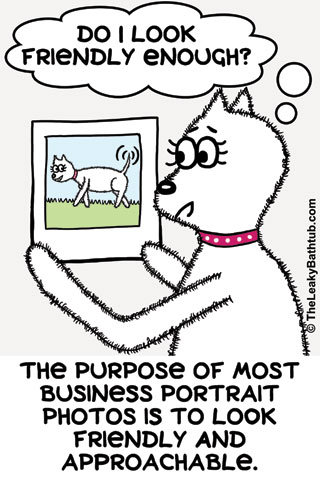 For many of us, having our business portrait taken is something that’s as excruciating as going to the dentist. More so, even, because the results will be displayed in public on a website and other marketing materials for all to see.
For many of us, having our business portrait taken is something that’s as excruciating as going to the dentist. More so, even, because the results will be displayed in public on a website and other marketing materials for all to see.
So we drag ourselves in front of the camera; grimace as we smile; and hope that the result is usable.
Chances are, the resulting image is far from ideal and makes us cringe every time we see it!
Why is the resulting image likely to be disappointing? Because all too often your discomfort at being in front of the lens will have come through on camera. Your face might have smiled: but did the rest of your body?
Body language is hugely significant in business portraits
After all, when a prospect sees your business portrait online, they will make assumptions based on what’s in front of them. And that includes reading details into your body language. What’s that conveying? At the end of the day, the goal of a business portrait is to make you look friendly and approachable. Is your business portrait doing that?
Here are some of the body language factors you need to take into consideration when planning your business portrait session.
1. Should you smile with your mouth open – or with your mouth closed?
Whether we smile with our mouths open or closed is something we often don’t stop to think about. Yet when your profile photograph is being used on marketing material, readers will observe a lot about you and your company based on your body language. And that body language includes smiling.
Let’s look at two examples to see the difference between smiling with your mouth closed and your mouth open:
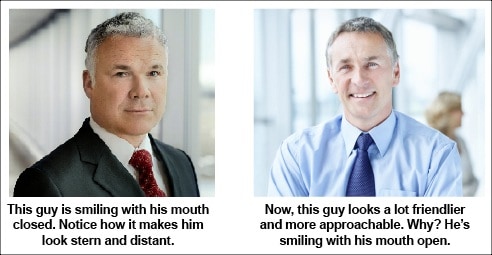
So should you smile with your mouth open or closed? In most instances, it’s more appropriate to smile with your mouth open: after all, you’re putting your photo on your website to give your company a human face. And as you want people to contact you, it’s appropriate to look friendly and approachable.
The only instance I can think of where a closed-mouth photo might be appropriate is for a fiction author who wants to be portrayed as mysterious and elusive. Other than that, I’d recommend a pleasant smile with teeth showing any time. If you’re concerned about your less-than-perfect teeth, that’s easy to fix up in photo editing software. So go ahead and smile for the camera!
2. Should you have your arms crossed or uncrossed?
In many business portrait photos you’ll see the subject with their arms crossed… after all, arms are awkward things, as it can be hard to make them look natural in photographs.
Crossing your arms can therefore be instinctive: but think about the body language that that’s communicating. Crossed arms mean you’re closing yourself away.It’s a defensive gesture. It makes the subject look uncomfortable; angry even. Look at these examples and judge for yourself.
Both the models are in very similar poses; both have wide, toothy smiles; and both are similarly attired. The only difference is that one lady has her arms crossed, and the other one has her arms at her side. Which do you think looks more approachable?
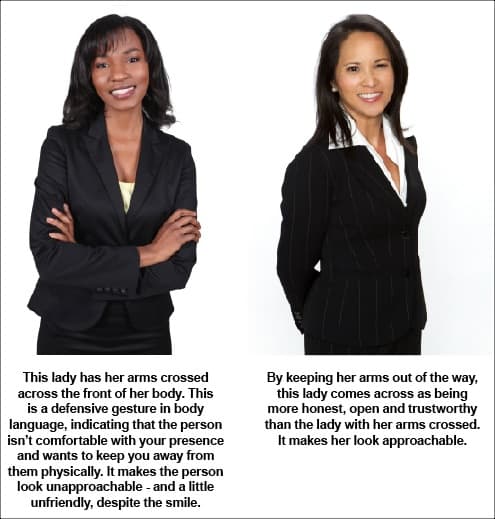
In short: avoid crossing your arms in your profile photo!
So what should you do with your arms?
In a whole body shot, it can be difficult to know what to do with your arms. We’ve already established that you shouldn’t cross your arms… so what should you do with them? Let’s look at some awkward looking arms first of all, so we know what not to do.
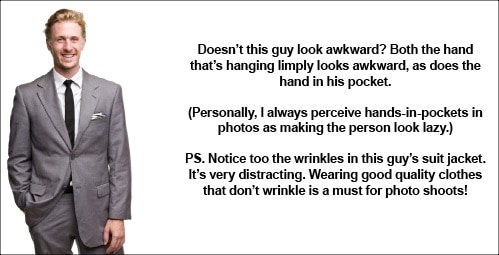
Now we know that these arms look awkward in the photograph, we can figure out what to do about them.
How to deal with awkward looking arms…
(a) Crop the arms out of the shot
The guy above looks awkward because he’s standing unnaturally. In fact, showing this guy from head to thigh isn’t adding anything to this photo. So let’s crop the image, to get rid of his arms (and all that wrinkled suit fabric):
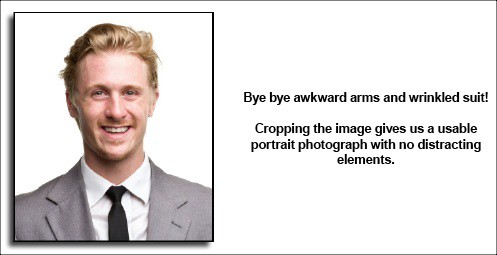
That’s better!
(b) Use action shots for whole-body photographs
If you want a whole body photograph, then consider making it an ‘action’ shot where you’re doing something. Here’s a great example:
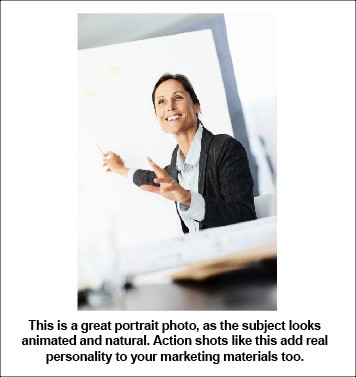
(c) Hold something
If you’re holding something, it can make your hands look a lot more natural, and make you look more relaxed. You’ve already seen the actions shot in the previous example, where the woman’s holding a pen. Even holding a pile of papers or a file can be helpful.
Just be careful if you’re holding a piece of technology, such as a cellphone or computer. Technology design is evolving so rapidly, that such items will date a photograph very quickly!
3. Jacket on or jacket off?
Suit jackets are likened to a ‘suit of armour’ for good reason: they protect us, and give us an air of authority. Let’s look at some photographs you’ve already seen to see this in practice:
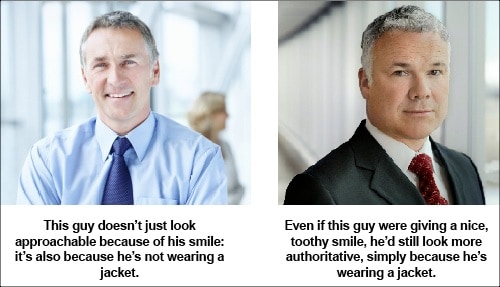
There’s no hard-and-fast rule about whether to wear a suit jacket or not in your portrait photo: you’ll need to decide for yourself if you want to come across as authoritative, or as being more approachable.
In my photo shoot, I took two different outfits along. One of me in a suit, in shots where I wanted to look authoritative. But I also took along a plain black top, for the shots where I wanted to look as approachable as possible.
4. Where do you look? Do you want the Mona Lisa Effect or Non-Mona Lisa?
Do you want your photographs to have the Mona Lisa Effect? Or Non-Mona Lisa Effect? Or both?
If you can have both kinds of photos done, that’s a good idea, as it’ll give you plenty of flexibility in your marketing materials.
For example, here are the Mona Lisa Effect photos from my own photo shoot:
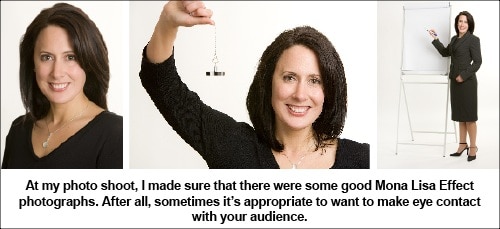
And here are the Non-Mona Lisa photos from my photo shoot:
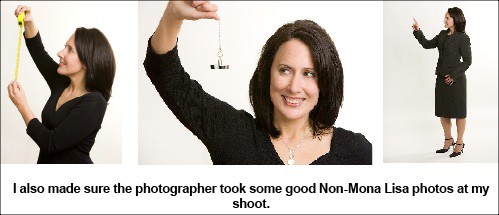
By having both Mona Lisa Effect and Non-Mona Lisa photos, I can choose whichever is the most appropriate for the marketing piece I’m working on. I recommend that you do the same.
Hint: Don’t be surprised if your photographer hasn’t heard of the Mona Lisa Effect, or that they think it’s weird you want some photos where you’re not making eye contact with the camera. Many portrait photographers (even very good ones) aren’t familiar with what makes a good marketing photograph. When I got my Non-Mona Lisa photos above done, my photographer thought I was wacky, but humoured me. And now I get lots of comments on my cool Non-Mona Lisa photos…! 😉
By following these tips, not only will you have some great business portrait shots, but because you know what sort of outcome you want, you’ll feel more confident working with the photographer, too.
Summary:
- Smile with your mouth open.
- Will your arms be in the shot? If so, keep your arms uncrossed – and find some way of making your arms look natural in the photograph, e.g. by holding something.
- Decide whether it’s appropriate to have your suit jacket on or off, or both.
- Decide whether you want your photos to have the Mona Lisa Effect, Non-Mona Lisa, or both.



